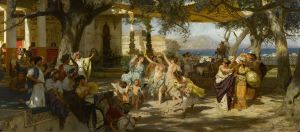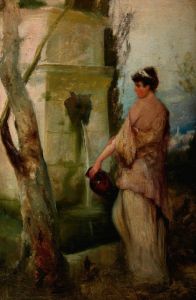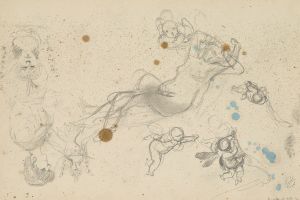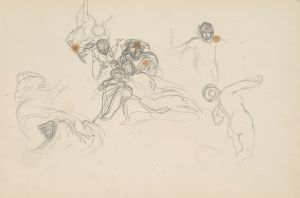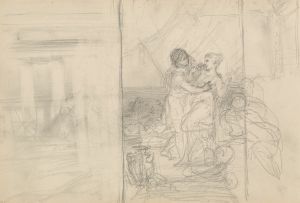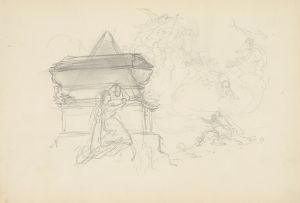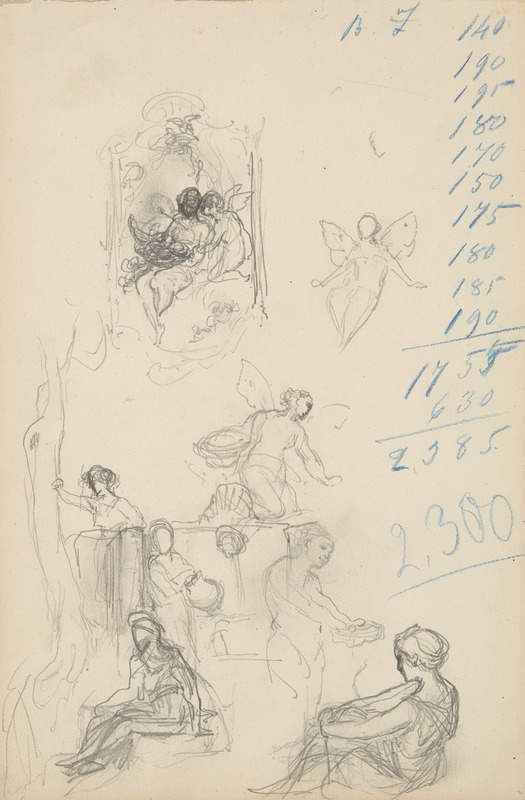
szkice do plafonu ‘Jutrzenka’ do pałacu J. Neczajewa-Malcewa w Petersburgu oraz szkice kobiet w strojach antycznych
A hand-painted replica of Henryk Siemiradzki’s masterpiece szkice do plafonu ‘Jutrzenka’ do pałacu J. Neczajewa-Malcewa w Petersburgu oraz szkice kobiet w strojach antycznych, meticulously crafted by professional artists to capture the true essence of the original. Each piece is created with museum-quality canvas and rare mineral pigments, carefully painted by experienced artists with delicate brushstrokes and rich, layered colors to perfectly recreate the texture of the original artwork. Unlike machine-printed reproductions, this hand-painted version brings the painting to life, infused with the artist’s emotions and skill in every stroke. Whether for personal collection or home decoration, it instantly elevates the artistic atmosphere of any space.
Henryk Siemiradzki was a Polish painter known for his large-scale historical and mythological scenes, often infused with a sense of drama and rich detail. One of his notable works includes the sketches for the ceiling painting "Jutrzenka" (Aurora) for the palace of J. Neczajew-Maltsew in St. Petersburg, as well as sketches of women in ancient costumes. These works exemplify Siemiradzki's mastery in capturing the essence of classical antiquity and his ability to translate historical themes into visual art.
The "Jutrzenka" sketches were part of a larger commission for the palace of J. Neczajew-Maltsew, a prominent figure in St. Petersburg. The palace itself was a testament to the opulence and grandeur of the era, and Siemiradzki's contribution was intended to enhance its aesthetic appeal. The subject of "Jutrzenka," or Aurora, the Roman goddess of dawn, was a fitting choice for a ceiling painting, symbolizing the arrival of light and the beginning of a new day. Siemiradzki's interpretation likely involved a dynamic composition, capturing the goddess in motion, surrounded by other mythological figures, a common motif in his work.
In addition to "Jutrzenka," Siemiradzki's sketches of women in ancient costumes reflect his deep interest in classical themes and his meticulous attention to historical accuracy. These sketches were not merely preparatory works but were valued as standalone pieces that showcased his skill in rendering the human form and drapery. The women depicted in these sketches are often adorned in flowing garments, typical of ancient Greek or Roman attire, highlighting Siemiradzki's ability to convey texture and movement through his brushwork.
Siemiradzki's work was heavily influenced by his academic training and his exposure to the art and culture of Italy, where he spent a significant portion of his career. He studied at the Imperial Academy of Arts in St. Petersburg and later in Munich, but it was his time in Rome that profoundly shaped his artistic style. The classical ruins, Renaissance art, and the vibrant artistic community in Rome provided endless inspiration for his historical and mythological subjects.
Throughout his career, Siemiradzki received numerous accolades and was widely recognized for his contributions to the art world. His works were exhibited in major European cities, and he was a member of several prestigious art academies. Despite the changing tastes in art towards the end of the 19th century, which saw a shift away from academic painting, Siemiradzki remained a respected figure, known for his technical prowess and his dedication to the grand tradition of history painting.
In summary, Henryk Siemiradzki's sketches for "Jutrzenka" and his depictions of women in ancient costumes are exemplary of his fascination with classical themes and his skillful execution. These works not only contributed to the decorative splendor of the Neczajew-Maltsew palace but also underscored Siemiradzki's position as a leading artist of his time, celebrated for his ability to bring historical and mythological narratives to life through his art.






![Drawings for proposed decorations of Mike Lyman’s Restaurant, 424 W. Sixth St., Los Angeles, CA.] [Color scheme for ceiling, playroom – bar – foyer](/imgs/249337/s/winold-reiss-drawings-for-proposed-decorations-of-mike-lymans-restaurant-424-w-sixth-st-los-angeles-ca-color-scheme-for-ceiling-playroom-bar-foyer-ba71c61c.jpg)
![Floral design for pier, capital, and ceiling.] [Perspective elevation drawing](/imgs/249344/s/winold-reiss-floral-design-for-pier-capital-and-ceiling-perspective-elevation-drawing-f863e626.jpg)
![Drawings for proposed decorations of Mike Lyman’s Restaurant, 424 W. Sixth St., Los Angeles, CA.] [Drawing #10, Scheme 1; Color scheme for ceiling – main dining room](/imgs/249426/s/winold-reiss-drawings-for-proposed-decorations-of-mike-lymans-restaurant-424-w-sixth-st-los-angeles-ca-drawing-10-scheme-1-color-scheme-for-ceiling-main-dining-room-6113fb5a.jpg)
![Interior designs for screens and ceilings.] [Drawing of plans, elevation, and details](/imgs/249429/s/winold-reiss-interior-designs-for-screens-and-ceilings-drawing-of-plans-elevation-and-details-228c6d94.jpg)
![Design for reflected ceiling plan.] [Partially colored drawing for ceiling plan](/imgs/249463/s/winold-reiss-design-for-reflected-ceiling-plan-partially-colored-drawing-for-ceiling-plan-11749db9.jpg)
